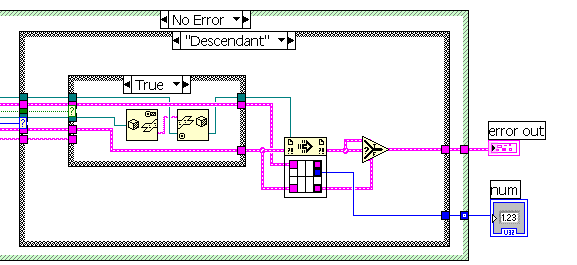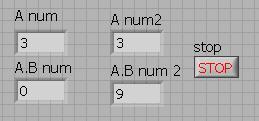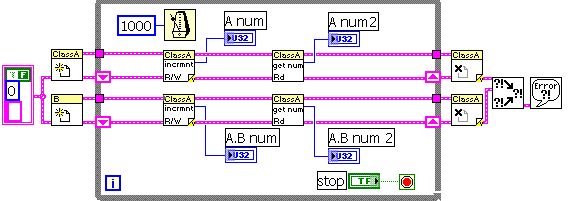
Elktro
Members-
Posts
18 -
Joined
-
Last visited
Profile Information
-
Gender
Male
LabVIEW Information
-
Version
LabVIEW 2011
-
Since
2008
Elktro's Achievements
-
I'm using labview verison 2011 sp1 (11.9.1f2 (32-bit)) and I am trying to compile, but I run to error. I am getting following error: The build was unsuccessful. Possible reasons: Details: Which is very strange because some of my vi are indeed using MBT.dll but not from "C:MyTempF02" directory, and the startup vi is running just fine without any errors as are the vi's that are using the MBT.dll. I have added MBT.dll library to my project and location in the properties dialog shows the real location not the "C:MyTempF02" where the compiler tries to find it. I have also tried to just make a new build specification (by clicking it and selecting New -> Application (exe)), but still the same error occures. What to do?
-
I have a subvi A which takes as an input an arbitrary sized array of double values. The subvi A calls a subvi B which is a reentrant. Now I would like to call the subvi B for each double member of the input array. This would be no problem if I could use for loop. However I want call the subvi B for each double member simultaneously. The subvi B has an output value. A parallel for loop could be a solution, but that is only available in LabVIEW 2009. Is there anyway to do this with labVIEW 7.1? Sounds something that could maybe be done with dynamically called subvis, but Is there any neater way?
-
Well, classic buttons don't have shadows, but they are ugly! Anyway, you can't delete picture items of classic buttons either.
-
I am customizing a push button control. I added a regular push button control on the front panel and navigated through advanced > customize. I wanted to delete the shadow background of the push button, but wasn't able to delete any of the picture items. As a work a round I resized the shadow pictures to small sizes and made them transparent. But how on earth do I remove them completely?
-
SciWare GOOP + DAQ task = task disappears
Elktro replied to Elktro's topic in Object-Oriented Programming
I'm not quite sure when subVI is in a idle state, but the SubVI that creates the task goes into "SubVI waiting to run"-state. But how can I make a subVI not to go idle when exiting from a subVI? -
I have been trying to create a channel with DAQmx Create Channel (AI-Voltage-Basic) in a Sciware GOOP class. The DAQmx gives me a task, which I start and then direct the task to the appropriate data member of the class. So far everything goes fine. However, when I retrieve the task from the data member to acquire a voltage value, I get the following error: Error -200429 occurred at DAQmx Read (Analog DBL 1Chan 1Samp).vi Possible reason(s): Measurements: Value passed to the Task/Channels In control is an empty string (or I/O control). The value must refer to a valid task or valid channels. So where did the task disappear? Please, see the attached code. DAQmx_task_test.zip
-
To Retrieve previously created object, named instances can be use. However, I found that if I have class A with child class B, and I have created an object by class B, I cannot retrieve the object by calling the object creator of the parent class A. No problems with retrieving the object with the object creator of the child class B. Is there a way to retrieve object by its instance name with the object parent class? Workarounds are welcome too. Using LabVIEW 7.1
-
Virtual method output of base class vs. child implementation.
Elktro replied to Elktro's topic in Object-Oriented Programming
Yes, both should have num field as B class inherits it from its parent class classA, which has a num field. I don't quite see what you mean. How could the instances write each other's data members, if they are clearly in their own separate sequences? -
Virtual method output of base class vs. child implementation.
Elktro replied to Elktro's topic in Object-Oriented Programming
I found the problem! I just needed to wire output from the child implementation in the Descendant. (Dah!) It is so easy when you know it. -
Using SciWare's GOOP Developer 2.3 I have made ClassA and a child class B, which both have their own increment() virtual method. The base class method increments data member num by 1, and the B class increment data member num by 3. Both methods give incremented value as an output. The data member num has also a getter. I have made the demo below to illustrate my question. The two instances of the ClassA and B are called by their own implementation of increment and after incrementation num value is get. The base class ClassA part works as intended: num value is incremented and the value gotten from the increment method is the same as the value gotten from the getter. The child class B part, however, doesn't work the same way: the num value is incremented, but increment method return 0, although the getter shows that the value is indeed incremented in each loop execution. Here is the front panel after while loop has executed 3 times: So why the 0 output?
-
SciWare GOOP Developer, whether or not reentrant?
Elktro replied to Elktro's topic in Object-Oriented Programming
Yeah of course! Found it at Vi Properties -> execution. thanks -
How to initialize feedback node inside a while loop for every while
Elktro replied to Elktro's topic in LabVIEW General
I have now found very satisfactory solution. The thing to realize is that the "result" must be zero for first loop execution. Thanks for quick answers! Ilkka



